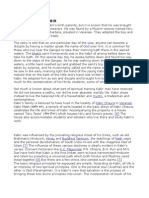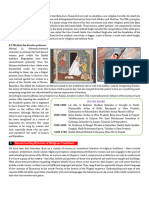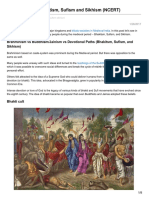Class Notes: Q.1. Describe The Origin of Bhakti Movement
Class Notes: Q.1. Describe The Origin of Bhakti Movement
Uploaded by
Mansi SinghCopyright:
Available Formats
Class Notes: Q.1. Describe The Origin of Bhakti Movement
Class Notes: Q.1. Describe The Origin of Bhakti Movement
Uploaded by
Mansi SinghOriginal Title
Copyright
Available Formats
Share this document
Did you find this document useful?
Is this content inappropriate?
Copyright:
Available Formats
Class Notes: Q.1. Describe The Origin of Bhakti Movement
Class Notes: Q.1. Describe The Origin of Bhakti Movement
Uploaded by
Mansi SinghCopyright:
Available Formats
Class Notes
Class: XII Topic: CH-6. BHAKTI-SUFI TRADITIONS: CHANGES IN
RELIGIOUS BELIEFS AND DEVOTIONAL TEXT (C. EIGHT
Subject: HISTORY
TO EIGHTEENTH CENTURY
Q.1. Describe the origin of Bhakti Movement.
ANS: Causes of the Origin of the Bhakti movement -
Evil practices of the Hindus.
Fear of spread of Islam
Influence of Sufi Sects.
Influence of Vaishnavism
Emergence of great reformers - e.g. Namdeva, Ravidas, Ramanand, Surdas, Tulsidas, Mirabai, Kabir
etc.
8. New Devotional Paths Dialogue and Dissent in Northern India:
Many poet-saints engaged in explicit and implicit dialogue with these new social situations, ideas and.
Institutions.
8.1 WEAVING A DIVINE FABRIC: KABIR (For reading only)
Kabir (fourteenth-fifteenth centuries) is one of the most outstanding examples of a poet saint
in this context.
Kabirdas (Kabir itself is an Arabic word meaning “great”), was raised by a poor Muslim family
belonging to the community of weavers or julahas, who were relatively recent converts to Islam.
Verses ascribed to Kabir have been compiled in three distinct but overlapping traditions.
Life and teachings of Kabir (For reading only)
Kabir was born in a Hindu family (Kabirdas) but was raised by a poor Muslim family belonging to the
community of weavers or julahas, who were relatively recent converts to Islam. They also suggested
that he was initiated into bhakti by a guru, perhaps Ramanand.
Kabir was one of the most outstanding examples of a poet-saint who emerged in North India.
Verses.ascribed to Kabir have been compiled in three distinct but overlapping traditions. The Kabir
Bijak is preserved by the Kabirpanth in Varanasi and in Uttar Pradesh; the Kabir Granthavali is
associated with the Dadupanth in Rajasthan, and many of his compositions are found in the Adi
Granth Sahib.
Kabir’s poems have survived in several languages and dialects; and some are composed in the special
language of nirguna poets, the sant bhasha. Others, known as ulatbansi (upside-down sayings), are
‘Content Developed/Prepared Absolutely From Home’
written in a form in which everyday meanings are inverted.
Kabir’s mystical experiences are many to describe the Ultimate Reality. These include Islam: he
described the Ultimate Reality as Allah, Khuda, Hazrat and Pir.
He also used terms drawn from Vedantic traditions, alakh (the unseen), nirankar formless), Brahman,
Atman, etc. Other terms with mystical connotations such as shabda (sound) or shunya (emptiness)
were drawn from yogic traditions.
Diverse and sometimes conflicting ideas are expressed in these poems. Some poems draw on Islamic
ideas and use monotheism and iconoclasm to attack Hindu polytheism and idol worship; others use
the Sufi concept of love to express the Hindu practice of Nam-simaran (remembrance of God’s
name).
Scholars have tried to analyze the language, style and content to establish which verses could be in
Kabir’s. What this rich corpus of verses also signifies is that Kabir was and is to the present a source of
inspiration for those who questioned entrenched religious and social institutions, ideas and practices
their search for the Divine.
However, the verses attributed to Kabir use the words guru and sat guru, but do not mention the.
name of any specific preceptor. Historians have pointed out that it is very difficult to establish and
Kabir were contemporaries, without assigning improbably long lives to either or both
Q.2.Describe the teaching of Kabir? How does he describe the ultimate reality through the poems?
ANS
1. Kabir (fourteenth-fifteenth centuries) is perhaps one of the most outstanding examples of a poet-
saint a who emerged within this context. Historians have painstakingly tried to reconstruct his life and
times through study of compositions attributed to him as well as later hagiographies.
2. Verses ascribed to Kabir have been compiled in three distinct but overlapping traditions.
3. The Kabir Bijak is preserved by the Kabirpanth (the path or sect of Kabir) in Varanasi and elsewhere in
Uttar Pradesh; the Kabir Granthavali is associated with the Dadupanth in Rajasthan, and many of his
compositions are found in the Adi Granth Sahib.
4. Kabir’s poems have survived in several languages and dialects; and some are composed in the special
language of nirguna poets, the sant bhasha. Others, known as ulatbansi (upside-down sayings), are
written in a form in which everyday meanings are inverted.
5. The range of traditions Kabir drew on to describe the Ultimate Reality include Allah, Khuda, Hazrat
and Pir. He also used terms drawn from Vedantic traditions, alakh (the unseen), nirakar (formless),
Brahman, Atman, etc.
‘Content Developed/Prepared Absolutely From Home’
6. Diverse and sometimes conflicting ideas are expressed in these poems. Some poems draw on Islamic
ideas and use monotheism and iconoclasm to attack Hindu polytheism and idol worship; others use
the sufi concept of zikr and ishq (love) to express the Hindu practice of nam-simaran (remembrance
of God’s name).
7. His valuable legacy, which is relevant for later generations, was claimed by several groups which is
most evident in later debates about whether he was a Hindu or a Muslim by birth.
The teaching of Kabir: (Important points)
(a) To achieve inward spiritual bliss
(b) Condemnation of empty ritual
(c) To faster harmony between Hinduism & Islam
(d) He believed in one formless God
(e) Rejected both Vedas & Kuran & the supremacy of the Brahmins & Mulas
(f) He opposed the caste system & image worship
(g) He taught the unity of god & the path of love & devotion
(h) He emphasized on bhakti to achieve salvation or Moksha.
Kabir gave different names of ultimate reality. In Islam these include Allah Hazrat, Khuda and Pir. He also used
terms taken from Vedantic traditions like alakh, nirankar, Brahman and atman.
‘Content Developed/Prepared Absolutely From Home’
You might also like
- Shri Hanuman Chalisa in Englisha PDFDocument3 pagesShri Hanuman Chalisa in Englisha PDFVipin SinghalNo ratings yet
- New Devotional Paths: Dialogue and Dissent in North IndiaDocument30 pagesNew Devotional Paths: Dialogue and Dissent in North Indiasayooj tvNo ratings yet
- Satguru Kabir: Al-Kabir ("The Great") Is Also One of The in Islam. For A Complete Disambiguation Page, SeeDocument5 pagesSatguru Kabir: Al-Kabir ("The Great") Is Also One of The in Islam. For A Complete Disambiguation Page, SeeKhawerEijazNo ratings yet
- Ahw 2309091434 1321325976 1Document8 pagesAhw 2309091434 1321325976 1krishikasingla79No ratings yet
- Kabir Das HistoryDocument3 pagesKabir Das HistorySriram SusarlaNo ratings yet
- Kabir: God Bhakti RamanandaDocument15 pagesKabir: God Bhakti RamanandaJitendra Kumar DixitNo ratings yet
- GS-1 (Modal Asn) EngDocument33 pagesGS-1 (Modal Asn) Engsdmarijit99No ratings yet
- Sant Kabir Das Seminar ProjectDocument16 pagesSant Kabir Das Seminar ProjectKrishna25% (4)
- Vq122LlICHX7xsfBXYsr CompressedDocument4 pagesVq122LlICHX7xsfBXYsr CompressedIvyNo ratings yet
- Presentation Bhakti SufiDocument3 pagesPresentation Bhakti Sufiayonroy334No ratings yet
- NCERT Solutions For Class 12 History Chapter 6 Bhakti-Sufi TraditionsDocument4 pagesNCERT Solutions For Class 12 History Chapter 6 Bhakti-Sufi Traditionsvikas chauhan100% (1)
- History Chapter 7 Devotional Paths To The Divine: Ncert QuestionsDocument4 pagesHistory Chapter 7 Devotional Paths To The Divine: Ncert QuestionsKomal PanchalNo ratings yet
- 12 History Ncert Ch06Document10 pages12 History Ncert Ch06manpreet kaurNo ratings yet
- Saint Kabir: Early Life and BackgroundDocument2 pagesSaint Kabir: Early Life and BackgroundSanskruti ChavanNo ratings yet
- Shifts in Kabīr Contexts and Texts - Imre BanghaDocument48 pagesShifts in Kabīr Contexts and Texts - Imre BanghaprachandNo ratings yet
- Section V Bhakti MovementsDocument7 pagesSection V Bhakti MovementsMammen JosephNo ratings yet
- History of India AssignmentDocument5 pagesHistory of India AssignmentUjjwal YadavNo ratings yet
- ch2 2Document6 pagesch2 2parneet1078No ratings yet
- Sant KabirDocument7 pagesSant KabirmehaldksinghNo ratings yet
- CH-6 Bhakti and Sufi Traditions (H)Document34 pagesCH-6 Bhakti and Sufi Traditions (H)ayushvasu06No ratings yet
- Biography Presentation PA113Document8 pagesBiography Presentation PA113pallavi.magar0605No ratings yet
- Bhakti and Sufi ChapterDocument9 pagesBhakti and Sufi ChapterkrishanNo ratings yet
- Mystic Fervour and Similarities in The PDocument13 pagesMystic Fervour and Similarities in The PAllMoravideNo ratings yet
- Composite CultureDocument5 pagesComposite Culturearkoprovobagchi2009No ratings yet
- Lesson 2 - BhaktiDocument22 pagesLesson 2 - BhaktiSomesh ChakrabortyNo ratings yet
- Bhakti and Sufi TraditionsDocument10 pagesBhakti and Sufi TraditionskyoNo ratings yet
- CC7 Mod4bDocument6 pagesCC7 Mod4bkaushal yadavNo ratings yet
- Afro Asian HandoutsDocument15 pagesAfro Asian HandoutsNemwel Quiño Capol100% (1)
- Bhakti Movement in IndiaDocument4 pagesBhakti Movement in Indiachukogrande100% (1)
- Part-II: CHAPTER 2 Bhakti Sufi Traditions Class 12 Notes History Key Concepts in NutshellDocument12 pagesPart-II: CHAPTER 2 Bhakti Sufi Traditions Class 12 Notes History Key Concepts in NutshellGaurangi OberoiNo ratings yet
- Theme 6 - Bhakti and Sufi TraditionsDocument29 pagesTheme 6 - Bhakti and Sufi Traditionssayooj tvNo ratings yet
- Literature Through Ages (Freeupscmaterials - Org)Document21 pagesLiterature Through Ages (Freeupscmaterials - Org)SilversterNo ratings yet
- Painting from the Palette of Love: The Mystical Poetry of KabirFrom EverandPainting from the Palette of Love: The Mystical Poetry of KabirNo ratings yet
- 101259MCS Paper I E28093 PDFDocument20 pages101259MCS Paper I E28093 PDFSoham ChauhanNo ratings yet
- LITERATUREDocument52 pagesLITERATURERoselle RaguindinNo ratings yet
- Question 2Document20 pagesQuestion 2abhinavk64103No ratings yet
- KabirDocument14 pagesKabirAmit KumarNo ratings yet
- About KabirDocument32 pagesAbout KabirAnushiya ChandranNo ratings yet
- Kabir & KalidasaDocument20 pagesKabir & KalidasaGaurav Kumar75% (4)
- Chapter 6 class 12 history qstnnaire 2Document3 pagesChapter 6 class 12 history qstnnaire 2Aakriti BhuyanNo ratings yet
- Hindi Literature PDFDocument2 pagesHindi Literature PDFpiyush KesarwaniNo ratings yet
- Survey of Afro - CbeDocument56 pagesSurvey of Afro - CbeRichel SandovalNo ratings yet
- Unit 2 The Mad Lover' by Sisir Kumar Das: 2.0 ObjectivesDocument11 pagesUnit 2 The Mad Lover' by Sisir Kumar Das: 2.0 ObjectivesAditi Dalal0% (1)
- Kabir Oral To Manuscript Transitions - Oral Tradition - P FriedlanderDocument16 pagesKabir Oral To Manuscript Transitions - Oral Tradition - P FriedlanderprachandNo ratings yet
- Ijrpr2733 Kabir's PhilosophyDocument3 pagesIjrpr2733 Kabir's Philosophymazumdertanisha100No ratings yet
- Composite cultureDocument4 pagesComposite culturebhuvi.rathi0531No ratings yet
- Devotional Path To The Divine Class ViiDocument3 pagesDevotional Path To The Divine Class ViiSuhani GuptaNo ratings yet
- Afro AsianDocument28 pagesAfro AsianDEEFSEWFEWNo ratings yet
- St. Xavier'S High School Sector 49, Gurgaon: Worksheet-1 Devotional Paths To DivineDocument2 pagesSt. Xavier'S High School Sector 49, Gurgaon: Worksheet-1 Devotional Paths To DivineVaibhav CoderNo ratings yet
- Cultures in Transition PDFDocument103 pagesCultures in Transition PDFAnushka NandkeolyarNo ratings yet
- A.Y. 21-22 - T5 - Kabir-The Poet of Vernacular Modernity - Purushottam AgrawalDocument3 pagesA.Y. 21-22 - T5 - Kabir-The Poet of Vernacular Modernity - Purushottam AgrawalGaryNo ratings yet
- Medieval India Bhaktism Sufism and Sikhism NCERTDocument8 pagesMedieval India Bhaktism Sufism and Sikhism NCERTsagarthegameNo ratings yet
- General Education 2008 With AnswersDocument63 pagesGeneral Education 2008 With AnswersVanessa IlaganNo ratings yet
- Iwrbs Las2q4Document4 pagesIwrbs Las2q4Shalene Dale Panague CamayudoNo ratings yet
- Bhakti and Sufi TraditonsDocument21 pagesBhakti and Sufi TraditonsTirsha BiswasNo ratings yet
- Class 12 History Notes Chapter 6 BhaktiDocument7 pagesClass 12 History Notes Chapter 6 BhaktiAhsas 60800% (1)
- History ProDocument19 pagesHistory ProRahul PandeyNo ratings yet
- World Literature Report On "Indian Poetry After Islam"Document10 pagesWorld Literature Report On "Indian Poetry After Islam"Muhammad Uraib razaNo ratings yet
- The Bhakti Movement and SufismDocument11 pagesThe Bhakti Movement and Sufismbhargobphukon528No ratings yet
- IWIL 2022 Test 1 GS 1 Art & Culture, Modern India, World HistoryDocument40 pagesIWIL 2022 Test 1 GS 1 Art & Culture, Modern India, World HistoryDaniel HoffNo ratings yet
- Purushotam Chowdary Final - EnglishDocument171 pagesPurushotam Chowdary Final - EnglishsainathefluNo ratings yet
- POEMS-The SONG of The SANNYASIN Swamivivekananda's Selected Complete Works BookDocument2 pagesPOEMS-The SONG of The SANNYASIN Swamivivekananda's Selected Complete Works BookamithhillshowNo ratings yet
- Hindutva Origin, Evolution and Future (Aravindan Neelakandan)Document1,192 pagesHindutva Origin, Evolution and Future (Aravindan Neelakandan)Edwin GodwinNo ratings yet
- Report On PashupatinathDocument17 pagesReport On Pashupatinathsnehi2242% (24)
- 119 - Hindu Law - FinalDocument20 pages119 - Hindu Law - FinalMohammed AminNo ratings yet
- Gujarat Industries - 13912Document1,249 pagesGujarat Industries - 13912maxisinc.inNo ratings yet
- Yajurveda - WikipediaDocument15 pagesYajurveda - Wikipediagangeshwar gaurNo ratings yet
- 12 - Chapter 1 PDFDocument30 pages12 - Chapter 1 PDFnswain76No ratings yet
- Govind Damodar Stotra 2Document3 pagesGovind Damodar Stotra 2KardamRishiNo ratings yet
- Brochure Mayapur Master PlanDocument11 pagesBrochure Mayapur Master Plangoswami.submissionsNo ratings yet
- 2012 Hindu CalenderDocument20 pages2012 Hindu CalenderProfMVSNo ratings yet
- We Want To Be Forced by The Spiritual Master (By BTS)Document3 pagesWe Want To Be Forced by The Spiritual Master (By BTS)Prerna UdhwaniNo ratings yet
- 108 Important Bhagavad-Gita SlokasDocument54 pages108 Important Bhagavad-Gita SlokasUnnikrishnan CBNo ratings yet
- NBS#129Document8 pagesNBS#129Nityam Bhagavata-sevaya E-magazine100% (1)
- History of AyurvedaDocument7 pagesHistory of AyurvedaVelladurai ENo ratings yet
- Guru Tattva 02-12 - Vyasa PujaDocument6 pagesGuru Tattva 02-12 - Vyasa PujaPañcama Veda DāsaNo ratings yet
- Secret KnowledgeDocument592 pagesSecret KnowledgeMognus CarlsonNo ratings yet
- Lesson 1 - Difference Between Animal and Human LifeDocument3 pagesLesson 1 - Difference Between Animal and Human LifeK CNo ratings yet
- Jeannie Fitzsimmons StoryDocument6 pagesJeannie Fitzsimmons Storykerrygraves0% (1)
- Science of Soul A PracticalDocument3 pagesScience of Soul A PracticalAndrea MarzocchiniNo ratings yet
- Yogeshvar Isahasran AmastotramDocument20 pagesYogeshvar Isahasran Amastotramnse9791No ratings yet
- 1 Sources of Hindu LawDocument26 pages1 Sources of Hindu LawEmlin JobithaNo ratings yet
- Bhava Prakash Samhita PurvaIIDocument71 pagesBhava Prakash Samhita PurvaIIven_bams5840No ratings yet
- AP New Paid QC ListDocument85 pagesAP New Paid QC ListbecpavanNo ratings yet
- STEAMR Duty list-REVISEDDocument9 pagesSTEAMR Duty list-REVISEDYogesh Kumar LaddhaNo ratings yet
- Travels of Guru Nanak in SikkimDocument394 pagesTravels of Guru Nanak in SikkimdoonsikhNo ratings yet
- Shiv StoramDocument3 pagesShiv Storamrahul.maniNo ratings yet
- (Culture of The Land) Todd LeVasseur - Pramod Parajuli - Norman Wirzba - Religion and Sustainable Agriculture - World Spiritual Traditions and Food Ethics-University Press of Kentucky (2016)Document385 pages(Culture of The Land) Todd LeVasseur - Pramod Parajuli - Norman Wirzba - Religion and Sustainable Agriculture - World Spiritual Traditions and Food Ethics-University Press of Kentucky (2016)tazzycaNo ratings yet
- Kumari Kandam Was A Mythical Sunken Land That Was Believed To Have Existed in The Indian OceanDocument2 pagesKumari Kandam Was A Mythical Sunken Land That Was Believed To Have Existed in The Indian OceanSashi RazNo ratings yet

























































































